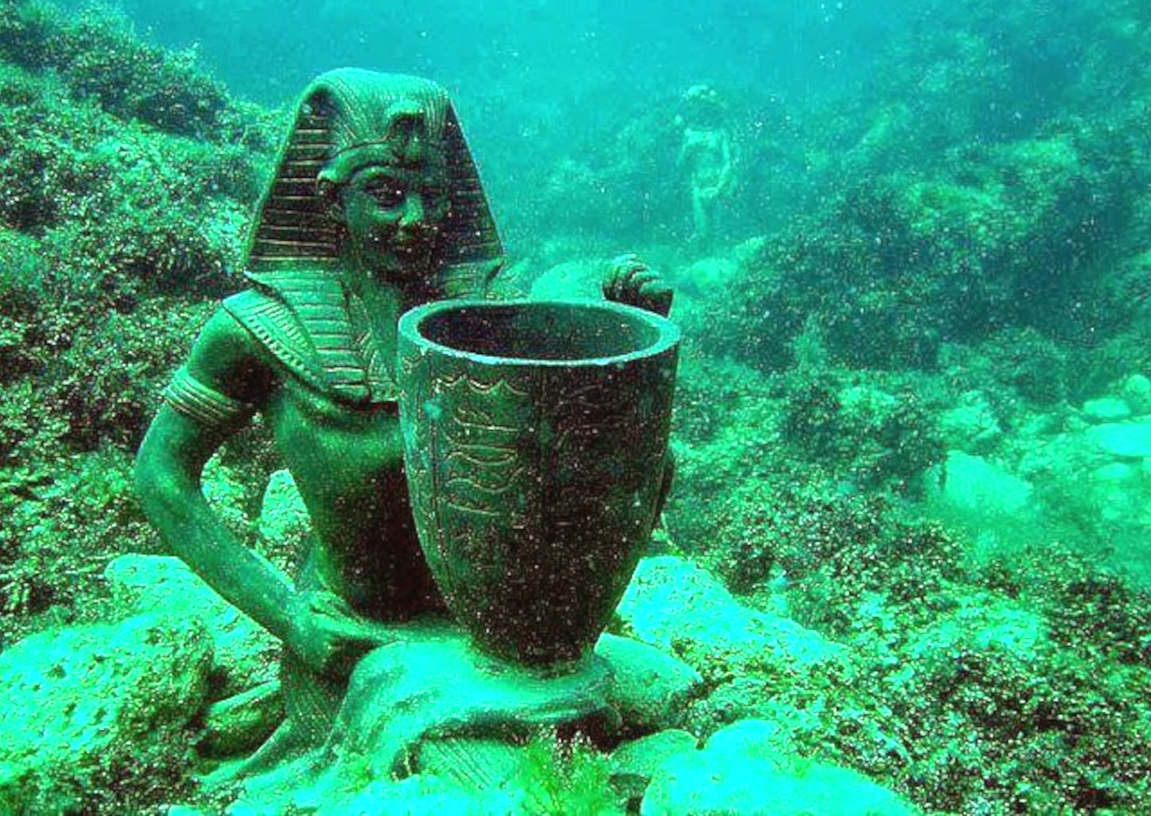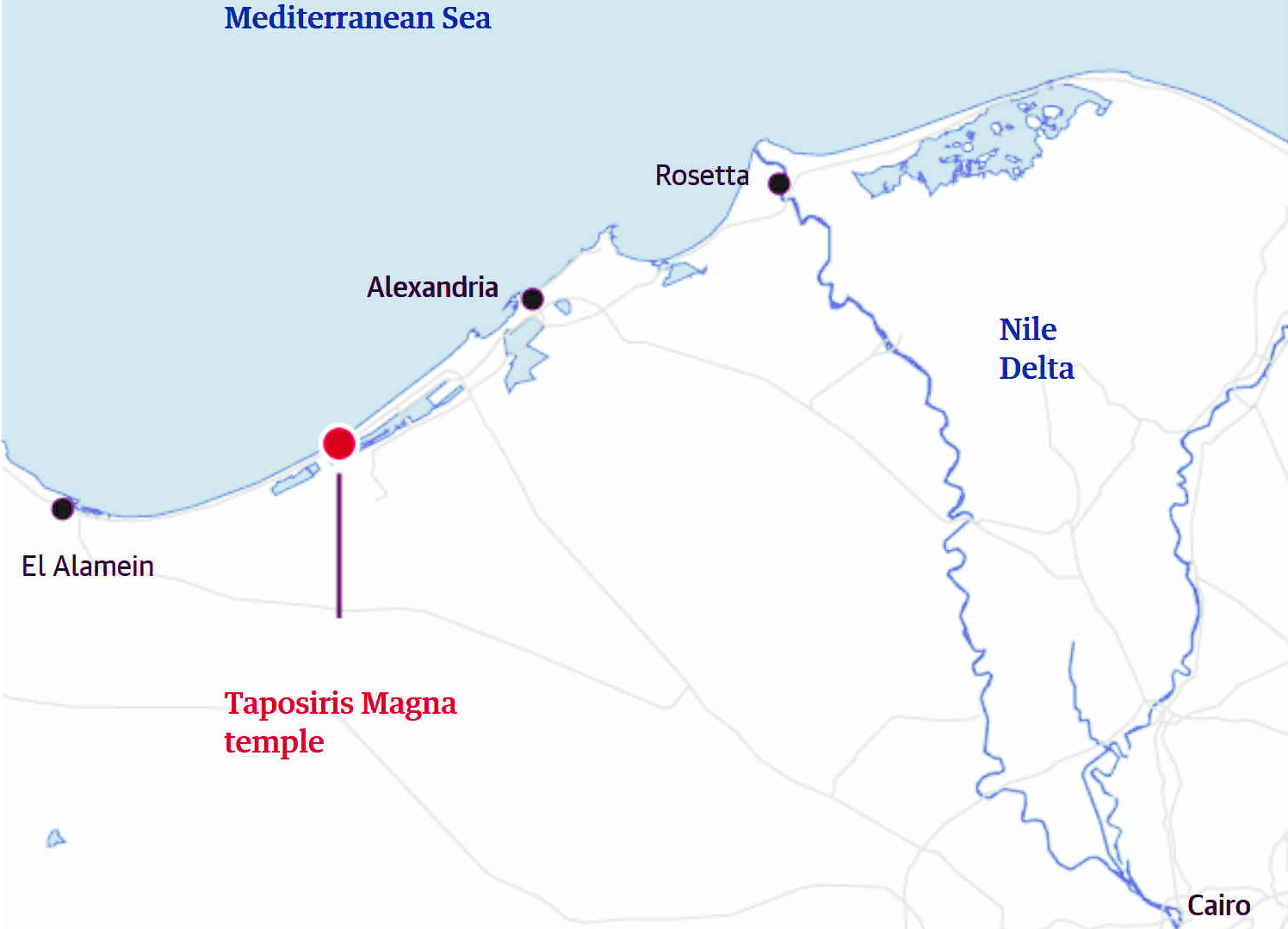|

Recently
(2021), while research work was underway at Thonis-Heracleion in the bay of
Abu Qir, intact fruit baskets have been discovered that were dated to the 4th century BC!
The ancient Egyptian port city of Thonis-Heracleion is located 32 kms northeast of Alexandria, in the
Mediterranean
Sea. The once Greek city was founded as early as the 12th century BC and was Egypt’s primary port until it was superseded by Alexandria in the 2nd century BC.
"They have lain untouched underwater (for) 2,400 years, maybe because they were once placed within an underground room or were buried soon after being offered," IEASM or the European Institute for Underwater Archaeology, led by French marine archaeologist
Franck Goddio said.
Thonis-Heracleion: Wiped Out by Earthquakes and Tidal Waves
Wicker baskets filled with fruit including doum nuts (the fruit of an African palm tree considered sacred by the ancient Egyptians) and grape seeds, along with hundreds of ancient ceramic artifacts and bronze
treasures have been discovered in the submerged ruins of Thonis-Heracleion, as reported by The Guardian.
The city would disappear under waves and water in the 2nd century BC, before sinking further in the 8th century AD following cataclysmic natural disasters, including an earthquake and tidal waves. In fact, several earthquakes followed by tidal waves led to a 42-square-mile (110-square-kilometer) portion of the Nile delta collapsing under the sea, taking with it the cities of Thonis-Heracleion and
Canopus.
Thonis-Heracleion (a combination of the city’s Egyptian and Greek names) was for centuries Egypt’s largest port on the
Mediterranean before Alexander the Great founded Alexandria in 331 BC, reports CNN Travel . Greeks were allowed to settle in the city during the late Pharaonic period (roughly between 660 BC and 330 BC) and built their own sanctuaries close to the massive temple of Amun.
The vast site in Aboukir Bay near
Alexandria was forgotten until its re-discovery by the French marine archaeologist Franck Goddio two decades ago. The discovery is one of the most fascinating underwater archaeological finds in recent years.
The Ancient Baskets May Have Been Used in Funerary Practices
Terming the finds “incredible”, Goddio added that “…Nothing was disturbed. It was very striking to see baskets of fruits.” There is an angle of religious ceremonies and ritual practices too – the baskets were stored in an underground room and may have been funerary practices , as per The Greek City Times . A tumulus-cum-burial mound, 197 x 26 feet (60 x 8 meters) was found nearby with an extravagant array of Greek funerary goods, most likely left by merchants and mercenaries who lived in the nearby area, as per IEASM.
“Everywhere we found evidence of burned material. Spectacular ceremonies must have taken place there. The place must have been sealed for hundreds of years as we have found no objects from later than the early fourth century BC, even though the city lived on for several hundred years after that. We found hundreds of deposits made of ceramic. One above the other. These are imported ceramic, red on black figures,” added Goddio.
Of the tumulus, Goddio waxes eloquently calling it “an island surrounded by channels.” In those channels, the researchers found large artifact deposits of bronzes, statuettes of
Osiris, the Egyptian goddess of fertility , and distinctive red-and-black Greek ceramics that were likely imported. The bronze artifacts included hundreds of splendid mirrors and statuettes.
The Thonis-Heracleion Site Will Yield Much More Treasure!
What adds to the mystery and intrigue surrounding this particular site is its scale and unclear purpose of the ceremony. The evidence suggests a spectacular ceremony that was not repeated again.
Subaquatic Temple and Countless Treasures Discovered in Egypt's Sunken City of Heracleion
Egyptian Alexandria - Ancient underwater finds revealed the Pharaonic roots of the Ptolemaic City
People were possibly barred from re-entering the space ever again as none of the artifacts found there are dated to later than the early 4th century BC. Yet, the city has examples of being lived in for hundreds of years after this ceremony. Goddio estimates that only 3% of the sunken city has been discovered and re-discovered in the 20 years since it was found.
Additionally, the archaeologists also found a unique Ptolemaic galley ship , 82 feet (25 meters) in length, built in the classical tradition using mortise-and-tenon joints. The Ptolemaic ship also featured ancient Egyptian construction designs, like a flat base perfect for navigating the shallow Nile delta.

Franck Goddio and his team, in cooperation with the Egyptian Supreme Council of Antiquities, were able to locate, map and excavate parts of the city of Thonis-Heracleion, which lies 6.5 kilometres off today’s coastline. The city is located within an overall research area of 11 by 15 kilometres in the western part of Aboukir Bay at a depth of approx. 10 metres. Research started in 1996. It took years to map the entire area. First discoveries could be made in 2000. Franck Goddio has found important information on the ancient landmarks of Thonis-Heracleion, such as the grand temple of Amun and his son Khonsou (Herakles for the Greeks), the harbours that once controlled all trade into Egypt, and the daily life of its inhabitants. He has also solved a historic enigma that has puzzled Egyptologists over the years: the archaeological material has revealed that Heracleion and Thonis were in fact one and the same city with two names; Heracleion being the name of the city for the Greeks and Thonis for the Egyptians.
The objects recovered from the excavations illustrate the cities’ beauty and glory, the magnificence of their grand temples and the abundance of historic evidence: colossal statues, inscriptions and architectural elements, jewellery and coins, ritual objects and ceramics - a civilization frozen in time.
The quantity and quality of the archaeological material excavated from the site of Thonis-Heracleion show that this city had known a time of opulence and a peak in its occupation from the 6th to the 4th century BC. This is readily seen in the large quantity of coins and ceramics dated to this period. The port of Thonis-Heracleion had numerous large basins and functioned as a hub of international trade. The intense activity in the port fostered the city’s prosperity. More than seven hundred ancient anchors of various forms and over 70 wrecks dating from the 6th to the 2nd century BC are also an eloquent testimony to the intensity of maritime activity here.
The city extended all around the temple and a network of canals in and around the city must have given it a lake dwelling appearance. On the islands and islets dwellings and secondary sanctuaries were located. Excavations here have revealed beautiful archaeological material such as bronze statuettes. On the north side of the temple to Herakles, a grand canal flowed through the city from east to west and connected the port basins with a lake to the west.
The underwater archaeological research in Thonis-Heracleion is ongoing until today. Franck Goddio estimates that only 5 percent of the city have yet been discovered.
Prior to its discovery in 2000 by the European Institute for Underwater Archaeology (IEASM), no trace of Thonis-Heracleion had been found. Its name was almost razed from the memory of mankind, only preserved in ancient classic texts and rare inscriptions found on land by archaeologists. The Greek historian Herodotus (5th century BC) tells us of a great temple that was built where the famous hero Herakles first set foot on to Egypt. He also reports of Helen’s visit to Heracleion with her lover Paris before the Trojan War. More than four centuries after Herodotus’ visit to Egypt, the geographer Strabo observed that the city of Heracleion, which possessed the temple of Herakles, is located straight to the east of Canopus at the mouth of the Canopic branch of the
River
Nile.
|
|
The
ocean has swallowed umpteen civilizations, just the past 10,000
years. We may never discover other lost towns and cities, such
as to understand our past, or even explore those we know of,
unless the secrets of the ocean are shared.
Ocean awareness,
or literacy is not presently high on
academic agendas. It is a shocking statistic that we know
more about Outer Space, than we do our underwater kingdom.
Televised documentary programmes have done a great deal to
make life under the waves more popular, highlighting the
marine litter problem that is of major concern to marine
biologists. With plastic now seen in the remotest corners of
the globe and deepest trenches of the ocean.
|

